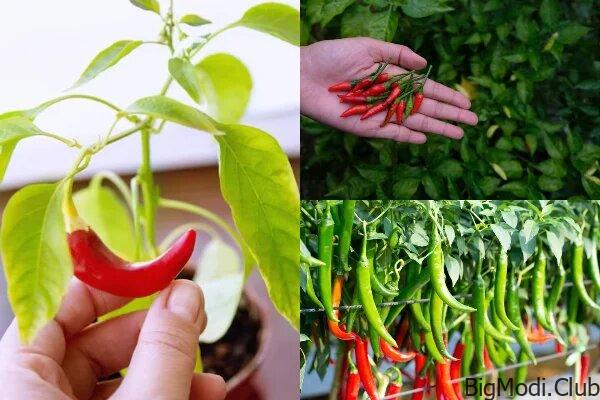Growing chilli peppers can be an exciting and rewarding journey. To successfully grow chilli peppers, you’ll need to pay close attention to several key factors, from seed germination to plant care. Whether you’re aiming to cultivate them indoors or outdoors, knowing how to grow chilli peppers effectively is crucial for a bountiful harvest. By following these detailed guidelines and best practices, you can ensure your chilli plants thrive and produce an abundant crop of fiery, flavorful peppers throughout the season.
How to Grow Chilli Peppers from Seeds
Growing chilli peppers from seeds can be a rewarding experience, but it requires attention to detail and patience. To get started, place 2-3 seeds in individual plugs or a seed tray. It’s essential to cover them with a thin layer of compost or seedling soil, ensuring they are planted at the right depth as indicated on the seed packet. Water the soil well, keeping it consistently moist—this is key to successful germination.
Maintaining Moisture and Light Conditions
Using seed trays is highly recommended as they come with lids that help retain moisture, reducing the need for constant watering. Keep the seeds in a dark area with minimal filtered light until you notice the first signs of life. Once sprouts appear, it’s time to remove the lid and move the tray to a south-facing windowsill. The increased sunlight will support the seedlings’ growth. At this stage, regular watering becomes even more important to keep the soil moist but not waterlogged.
Ensuring Proper Growth
As the sprouts grow, it’s a good idea to occasionally rotate the tray to ensure the plants grow upright. Young seedlings often lean toward the light source, so this small adjustment helps them grow straight. After 2-4 leaves have developed, it’s time for the first transplant. You can either carefully separate the seedlings or, if space is tight, cut the weaker ones at the soil level to allow the stronger plants to thrive.
Repotting for Continued Growth
Next, transfer each healthy seedling into a slightly larger pot, about 3 inches wide, using fresh seedling soil or compost. If your chilli plant begins to grow too tall or seems unstable, it’s time for another repotting. Choose a new pot that is both taller and wider than the previous one. Each time you repot, ensure the soil level almost reaches the leaves, which will provide the plant with greater stability as it grows.
Growing Chilli Peppers in Pots
Selecting the Perfect Spot and Pot
Growing chilli peppers in pots is an excellent way to enjoy these fiery fruits whether you have limited garden space or want to cultivate them indoors. Start by choosing a warm location for your peppers pots, whether that’s indoors by a sunny window or outside where they can bask in natural sunlight. Ensure the plants are shielded from strong winds and receive at least 6 hours of sunlight daily to thrive.
When it comes to the peppers pots themselves, opt for containers with good drainage. This is crucial to prevent waterlogging, which can lead to root diseases. A 5-gallon pot with a depth of around 12 inches is ideal for most single pepper plants. In warmer climates, you might need larger pots to accommodate the plant’s growth.
Preparing the Soil and Pot
For best results, use high-quality soil or potting mix that ensures proper drainage. Enrich the soil by mixing in compost or well-rotted manure before planting. This addition will enhance soil fertility and support robust plant growth.
Watering and Temperature
Maintaining the right moisture level is vital. Keep the soil consistently moist, but avoid overwatering, which can lead to root issues. As the peppers begin to mature, slightly reduce watering, but never let the soil dry out completely. The ideal temperature for growing chilli peppers in pots ranges between 70-90°F (21-32°C). This temperature range helps the plants flourish and produce a bountiful harvest.
Fertilization and Growth Management
Fertilize your chilli plants with tomato fertilizers, compost, or well-rotted manure. A balanced 5-10-10 fertilizer works well. Apply it once before transplanting and again after the peppers start to develop. To encourage a bushier growth habit, pinch the growing tip when the plant reaches about six inches high. Additionally, remove any early flowers to conserve the plant’s energy for stronger growth and fruit production.
Monitoring for Problems
Regularly check your plants for signs of common issues. Keep an eye out for diseases such as bacterial spot, mildew, or rotting. Pests like aphids and spiders can also become a problem, so be vigilant and address any infestations promptly.
How to Care for Chilli Plants
Transplanting Your Chilli Plants
Caring for chilli plants involves several key steps to ensure they thrive and produce a bountiful harvest. Once the roots have filled 9-10cm pots, it’s time to move your plants to their permanent growing positions. This is a crucial step in their development.
When transplanting, use larger pots—20-23cm (8-9 inches) in diameter filled with high-quality compost. The timing for this move varies based on your growing environment:
- Heated Greenhouse: Late April
- Unheated Greenhouse: Mid-May
- Outdoor Growing: Late May to early June
In addition to traditional pots, chillies can also be cultivated in grow bags. However, these require meticulous watering to maintain optimal moisture levels.
Encouraging Healthy Growth
To promote bushier growth and enhance fruit production, pinch out the growing tip when your plant reaches 15-20cm (6-8 inches) in height. This encourages the plant to develop a fuller shape and supports better cropping. If you prefer smaller chillies, you can also pinch back the side shoots.
Feeding and Watering
Regular watering is essential for maintaining healthy plants. Begin with a balanced general feed to support initial growth. As the first chillies start to form, switch to a high-potassium feed to boost fruit development and overall plant health.
Additional Care Tips
To prevent red spider mites and improve crop yield, mist the foliage regularly with tepid water. This practice is especially important when the plants are grown under cover, such as in greenhouses or grow tents.
How to Grow Chilli Peppers Indoors
Growing chilli peppers indoors can be a rewarding experience, allowing you to enjoy fresh, spicy peppers year-round. Whether you’re a seasoned gardener or a novice, following these tips will help you cultivate vibrant and productive plants.
Best Hot Peppers for Indoor Growing
When selecting chilli pepper varieties for indoor growing, opt for shorter plants known as ornamentals. Varieties such as Chile de Arbol, Cayenne, Bird Peppers, Pequin, Habañero, Piri Piri, Guajillo, Tabasco, Cherry, and Scotch Bonnet are excellent choices. These smaller peppers not only thrive in confined spaces but also tend to produce higher yields and have extended fruiting seasons, providing a continuous harvest over several weeks.
Creating the Ideal Indoor Environment
To ensure your chilli peppers flourish indoors, it’s crucial to replicate their natural habitat as closely as possible:
- Soil: Begin with premium potting soil that is well-aerated, loose, and fluffy. Enhance the soil with coco coir or woody mulches to improve its structure and drainage.
- Lighting: Chilli peppers require 14-16 hours of light each day. Use intense lighting with a blue spectrum to mimic natural sunlight. Position your grow lights at least 7 inches above the plant canopy to prevent overheating and ensure even growth.
- Temperature: Maintain daytime temperatures between 65°F to 80°F (18°C to 26°C) and nighttime temperatures between 60°F to 70°F (15°C to 21°C) for optimal plant health.
- pH Level: The ideal soil pH for chilli peppers is between 5.9 and 6.5. This range supports nutrient uptake and promotes vigorous growth.
- Nutrient Needs: During the vegetative stage, use a nitrogen-rich fertilizer (e.g., 11-3-8) to support robust leaf development. Once the peppers start forming, switch to a fertilizer with lower nitrogen but higher phosphate and potassium levels (e.g., fish and seaweed). Supplement with calcium-magnesium to prevent deficiencies.
Step-by-Step Guide to Growing Chilli Peppers Indoor
- Germinating Seeds: Chilli seeds can take anywhere from 7 to 100 days to germinate, depending on the variety. To speed up the process, place seeds in a damp paper towel inside a zip-lock bag on a heating pad. This warm, moist environment encourages faster sprouting.
- Preparing the Grow Room: Set up a hot and humid environment for your peppers. An AC Infinity Grow Tent is ideal, but a DIY setup can also work. Install LED grow lights to ensure your plants receive adequate illumination.
- Preparing the Container: Choose a 16″-18″ container filled with light, fluffy potting soil that includes larger organic materials for better aeration.
- Planting Seeds: Once the seeds have germinated, gently transfer them into the prepared container. Cover the seeds with soil and water thoroughly to ensure they establish well.
- Fertilizing: Peppers need a balanced nutrient mix. Avoid excessive nitrogen, which can impede flowering. Instead, focus on maintaining proper calcium levels and nutrient balance for healthy plant growth.
- Watering: Indoor peppers prefer drier soil, so water only when necessary. Test the soil moisture with your finger before watering. Consider using an automatic irrigation system to simplify the process.
- Supporting the Plants: As your peppers grow, they may become top-heavy, especially during fruiting. Use stakes or cages to provide support and prevent the plants from tipping over.
- Pollinating: Indoor chilli peppers are self-pollinating, but you may need to assist with pollen transfer. Gently vibrate the flowers using an electric toothbrush or your hand to stimulate pollen drop.
- Harvesting: Peppers typically take between 30 and 150 days to mature, depending on the variety. Harvest your peppers when they reach the desired color and spiciness.
Growing Indoors All Year
One of the greatest advantages of indoor growing is the ability to cultivate peppers throughout the year. Smaller, super-hot varieties like Carolina Reaper or Thai Chilis are particularly suited for indoor environments. With the right combination of fertilizers, lighting, and care, you can enjoy a steady supply of fresh chillies regardless of the season.
FAQs:
1. How long does it take for chili peppers to grow?
The time it takes for chili peppers to grow can vary depending on the variety and growing conditions. Typically, chili peppers take about 70 to 120 days from planting the seeds to harvesting mature peppers. This includes around 2 to 3 weeks for seed germination and an additional 10 to 16 weeks for the plants to mature and produce fruit.
2. What’s the best way to grow chili peppers?
The best way to grow chili peppers involves several key steps:
- Start from Seeds: Begin by sowing seeds in a seed tray or individual pots using quality seedling soil.
- Maintain Moisture: Keep the soil consistently moist but not waterlogged. Use seed trays with lids to retain moisture.
- Provide Adequate Light: Place the seedlings in a sunny spot or under grow lights. Chili peppers need plenty of light for healthy growth.
- Repot as Needed: Transfer seedlings to larger pots as they grow, ensuring they have enough space to develop strong roots.
- Ensure Proper Drainage: Use pots with good drainage and well-draining soil to prevent waterlogging and root diseases.
- Regular Feeding: Fertilize with a balanced fertilizer and adjust based on the growth stage of the plants.
3. Are chillies easy to grow?
Chili peppers can be relatively easy to grow if you follow proper care guidelines. They are generally hardy plants that thrive with minimal maintenance. However, they do require specific conditions such as warm temperatures, ample sunlight, and well-draining soil. With the right setup and attention to their needs, even beginners can successfully grow chili peppers.
4. Do chili peppers need sunlight?
Yes, chili peppers need sunlight to grow effectively. They require at least 6 to 8 hours of direct sunlight daily for optimal growth and fruit production. If growing indoors, use grow lights to mimic natural sunlight. Ensuring your chili peppers receive adequate light will help them develop strong plants and produce a plentiful harvest.


